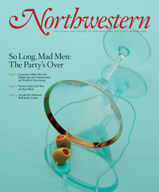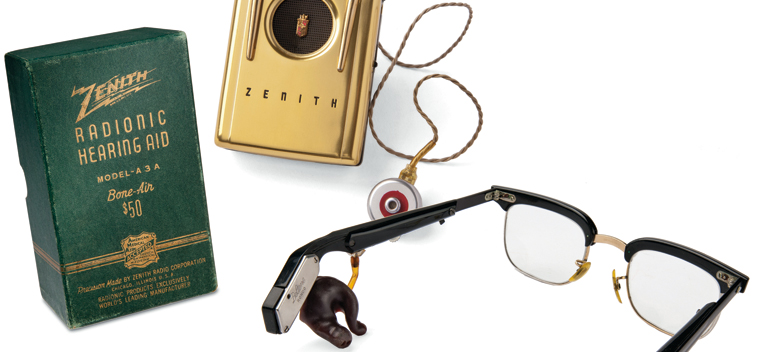Collections: The Evolution of Audiology
For information about hearing testing and hearing aids visit Northwestern’s Audiology Clinic website or call 847-491-3165. For more information on the hearing aid collection, email Don Nielsen, director of clinical education and translational research at the Audiology Clinic.
Tell us what you think. E-mail comments or questions to the editors at letters@northwestern.edu.
Ever wonder about those strange designations we use throughout Northwestern to identify alumni of the various schools of the University? See the complete list.
Find Us on Social Media
Audiology clinic collection highlights hearing aids through the years.
There was a time, says Don Nielsen, when hearing-impaired students “had to lug backpacks containing their hearing aid batteries everywhere they went.”
Nielsen, a hearing aid wearer himself, is director of clinical education and translational research at Northwestern’s Audiology Clinic, which houses a hearing aid collection — exhibit A for the evolution of audiology.
The collection began as a gift from an Evanston hearing aid dispenser, Tom Adams, to the clinic and Northwestern audiologist Elizabeth Fisher Dodds (C63, GC64). Hearing aid companies, faculty and staff have continued to add to it.
It includes speaking tubes that were common in the 1800s and cup-sized ear trumpets. Around the beginning of the 1900s hearing aid makers focused on making aids less conspicuous. For example, a set of eyeglasses had a hearing aid attached to the frame behind the ear.
The field of audiology grew to serve World War II soldiers who were returning home with hearing loss. Northwestern professor Raymond Carhart (GC34, 36), the “grandfather of audiology” and a seven-year captain in the Medical Administrative Corps, developed and refined speech audiometry, the measure of hearing ability, particularly related to the efficiency of hearing aids.
The electronic and technological advancements of the 1990s fast-tracked many improvements. Modern aids, for example, have front and back microphones. The back microphones filter out excess noise.
Nielsen, who wears the miniscule Lyric aid, marvels at the modern wonders. They require very little maintenance, he says. You sleep and shower with them in, and they’re unnoticeable. “I’m wearing mine now,” he says. “You can look as much as you want, but you’re never going to see it.”




 Facebook
Facebook Twitter
Twitter Email
Email


